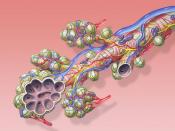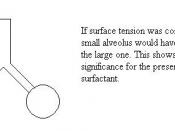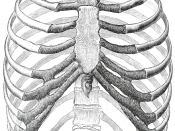Breathing is the act or process of respiration and it consists of two phases, inspiration and expiration. During inspiration, the diaphragm and the intercostals muscles contract. the diaphragm moves downwards increasing the volume of the thoracic (chest) cavity, and the intercostals muscles pull up the ribs to expand the rib cage and further increasing the volume of the alveoli (Blake, 2001). The increase of volume in the alveoli lowers the air pressure below the atmospheric pressure. As we all know that air always flows from a region of high pressure to a region of lower pressure. Because of this the air rushes in through the respiratory system into the alveoli (Blake, 2001). In contrast to inspiration, during expiration the diaphragm and intercostals muscles relax. This allows the thoracic cavity to return to its original volume. Because of this the air pressure inside the lungs is higher than the pressure outside the air is forced out (D, Galbraith, 2001).
When a breath is taken it consists of 78% hydrogen, 21% oxygen and 0.04% carbon dioxide. First the air passes in through the nostrils, through the nasal cavity, into the pharynx through the larynx, down the trachea into one of the main bronchi and it goes through smaller bronchioles and into the air sac called an alveolus (Blake, 2001). This is where the gas exchange occurs. The purpose of getting in oxygen is to get it through our bloodstream to the cells of our body in out cells it combines with glucose and food to produce usable ATP for every part of our body (D, Galbraith, 2000). The capillaries that surrounded the alveoli are involved in gas exchange between alveoli and blood. Oxygen is carried by the red blood cell as a oxyhemoglobin. Oxygen which is loosely bounded to the hemoglobin diffuses...


